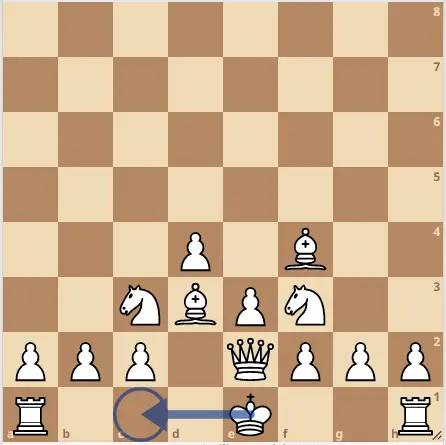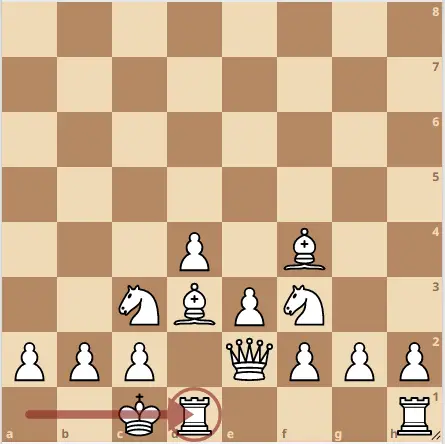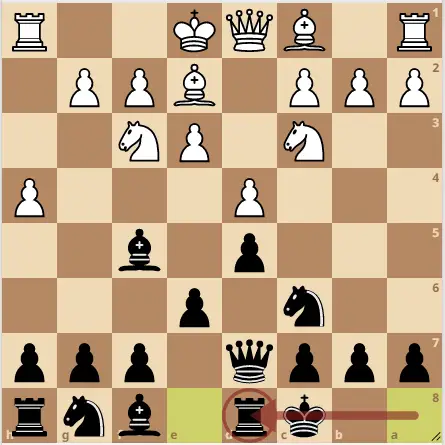As any chess player knows, there are two ways to castle – kingside and queenside or in other words short or long castle.
Kingside castling also known as short castle is the more common of the two, but queenside also known as long castle can be just as effective if used correctly.
In this blog post, we’ll take a look at how to castle long in chess, and some of the benefits and risks associated with this move. So whether you’re a beginner or an experienced player, read on to learn more about long castling in chess!
Castling Long For White
In order to castle long, there should be no pieces between the Rook on a1 and the king on e1. (either from the black or white side)
Note that long castling cannot occur if the king or the rook have already been moved in the game. Long castling also cannot occur if the king is in check. You cannot castle out of check either longside or shortside. That’s just how the rule goes.
To perform long castling for white move the king 2 spaces to the left so that it lands on the c1 square, meanwhile the a1 rook moves three spaces to the right as it jumps over the king and lands on the d1 square. All this occurs on one move and is the only time in chess that two pieces can move at once.
White king moves 2 squares to the left

White rook jumps over the king and lands on d1

Castling Long For Black
The same principle applies for black in long castling. This time the king moves 2 squares to the right and lands on c8, meanwhile the rook jumps over the king 3 squares to land on d8. The position below shows long castle for the black side:
Before castling long

After castling long

See how the black rook moves 3 squares to the left and jump over the king.
Some Important Things To Note When Castling Long
When castling long in chess there should be no enemy pieces attacking the c1 and d1 squares between the a1 rook and the king on e1. Similarly for black, the squares on c8 and d8 cannot be attacked or controlled by enemy pieces. For example the position below shows the black bishop cutting off the connection between the king and rook as it controls the c1 square.

Therefore castling cannot be performed as it is illegal to put your enemy king on an endangered square. The same is true for kingside castling which you can find out more here:
Can castling occur if the rook is attacked
You’d be surprised at how many seasoned chess players fail to grasp the concept of castling. For example, in this position the bishop is attacking the rook on a1. Some players will tell you that you cannot castle long as the rook is being attacked, but is that really true?

Definitely NOT. Just because your rook is being attacked doesn’t mean you cannot safely castle.
Since the squares between the a1 rook and the king are not controlled by enemy pieces (particularly c1 and d1), then it is perfectly fine to castle long.
The only exception is if your king is in check. And as we previously mentioned, the king cannot castle out of check as the rules stipulate.
The path to which the king long castles are the c1 and d1 squares, so as long as those squares are not under the influene of the enemy pieces, then the king is safe to castle long given that the b1, c1 and d1 squares are empty, and neither your king or rook has moved once in the game.
When is long castling useful?
Long castle is a very flexible move in chess and is useful in many circumstances. For example if you are being attacked on the kingside by your opponent, then castling long on the queenside can help protect your king.
If you are white and your opponent has black pawns and pieces that are well concentrated on the kingside and are threatening to open lines in front of your king, then it would be smart to castle long and avoid any potential mating attack. White castles long, and all his problems suddenly vanish.
Pawn storms
Another use of long castle on the queenside is to prepare a pawn storm on the enemy king. Pawn storm in chess is to move your flank pawns up the board to open lines and attack the enemy king.
This type of attack is often seen in openings like the Yugoslav attack vs the Sicilian dragon.
White castles queenside in preparation to exchange off the fianchettoed bishop on g7, launch his g and h pawns up the board and checkmate the black king!
Connecting the rooks
One of the most obvious reasons for castling queenside is to connect the rooks so they can become active.
Connecting the rooks is an extremely important strategy to take because your rooks need to shift along the back ranks and take control of crucial files like the c, d and e-files which most of the action takes place.
However, if the rook is stuck in the corner, it will not take part in the game unless you open the a-file or h-file with your flanks pawn which doesn’t occur that often.
In this position white should long castle, thereby connecting his rooks and keeping the white king safe.

It wouldn’t be a wise decision to castle short because the white king would be too opened for attacks as white already pushed his g and f pawns which are crucial in defending the king.
The Drawbacks Of Castling Long
We’ve looked at the pros of castling long in chess, however there is good and bad to everything. When castling long, the king will end up placed on the c1 square.
This weakens the a2 pawn because there isn’t enough pieces defending it. Therefore, you will have to waste a tempo by shifting your king over to the b2 square in order to add more protection to the a pawn.
Unlike long castle, kingside castle is much safer and doesn’t expel additional tempo. The king is safely tucked behind three pawns f, g and h pawns. All of which are protected by the king and helps safeguard the king from attacks.
So, Is Short Castle Better Than Long Castle?
The answer is yes. Short castle a.k.a kingside castle is much safer and effective than long castle because you don’t have to expel additional tempo to tuck the king in the corner unlike long castle.
In fact, short castle is more often played than long castle in most chess openings. Nevertheless, long castle can be an effective strategy given the right circumstances.
Some examples of chess opening where long castling is prominent are in the sicilian defenses as white such as the dragon, scheveningen variation etc.
Not to mention the Pirc defense queenside setup, the Scandinavian defense wth Qd6 as well as many other common openings.
Why Is it Called Queenside?
Queenside is the name given to half of the board where the queens reside. If you take a look at the chess board and piece position at the start of the game, the white and black queens are on the d1 and d8 squares respectively as they share the same half of the board.
The queenside for white is the left half of the board, where as the queenside for black is the right half of the board. This jargon is generally used while referring to which side you are castling,thus the name Queenside castling. The concpet holds true for the kingside.
The diagram below shows the queenside and kingside of the chess board.

History Of Long Castling
Castling was not always apart of chess, but it was one of the last moves added to the modern game, back around 1600 AD. And it was the result of an arms race!
You see, the original game brought from Persia (chatranj) had a much weaker bishop and queen. The bishop was originally the Elephant, and could only jump two squares diagonally.
The queen was the Ferz (or Visier) and could only move one square diagonally. (These pieces are retained in another offshoot of chatranj, Chinese Chess. And the piece names are retained in other languages: Ferz for queen in Russian, and Alfil for bishop in Spanish.)
With these weaker, short-range pieces, the opening developed much more slowly, and the king could afford to either stay in the center or slowly run to safety.
However, once chess was brought to Europe, the rules started changing to make the opening progress more quickly.
In the 1200s, the two-square pawn move was introduced (and the en-passant rule to counter it in the 1300s). And then around 1475 came the “Mad Queen” variant which gave the queen and bishop their modern long-range moves. This is documented in the first chess book published in 1497 by Lucena.
Early opening research found that you could quickly set up mating traps on the central king with moves like Bc4, and Qf3 or h5, and Nf3-g5. The first rule modification in the early 1500s to combat this was the “King’s Leap”: once per game, the king could jump two squares from its initial position to wriggle out of these mating nets. Some variants allowed any two square jump, even to the second or third rank!
But the most popular was soon found to be a two-move castle: Rf1, then king-leap of Kg1. (Look familiar?) This combined rook development with king safety.
Around the 1600s (1620 in France, 1640 in England) they abbreviated the King’s Leap to just the two modern castle moves (king-side and queen-side, all in one move), and the modern game of chess was finally in the shape we know it today. (In a few regions such as Rome and Russia, you had the choice of Re1 or Kh1 when castling, but that rule didn’t catch on.)
Final Verdict
One of the most important aspects of chess is learning how to castle properly. When done correctly, castling can be a powerful move that helps you gain an advantage over your opponent. Castling queenside is a bit different than castling kingside, but it’s still a vital part of the game.
A key point to remember whenever castling long is that the king always moves two squares and the rook jumps over the king so that it’s placed directly on the square next to the king. You must touch the king first – if you touch the rook, a rook move is expected and you won’t be able to castle.
You can learn more about the touch move rule here.


